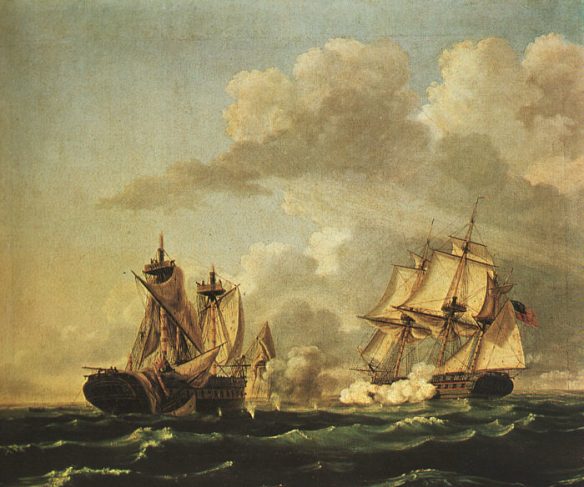March 10, 1783 – USS Alliance (CAPT John Barry) defeats HMS Sybil in final naval action of Revolution in West Indies waters.
JOHN BARRY. (1745?–1803).
Continental naval officer. Ireland. Born in County Wexford, Ireland, perhaps in 1745, John Barry went to sea at an early age, settling in Philadelphia around 1760. Over the next decade he became a prosperous shipmaster and owner. Congress gave Barry command of the brig Lexington on 14 March 1776. After a brisk fight on 17 April 1776, Barry captured the British sloop Edward, winning the U.S. navy’s first battle. Barry won further victories in 1776, seizing two more British ships in separate encounters and driving off a British attack off Cape May. Congress then awarded him command of the freshly built, thirty-two gun Effingham. While his ship was confined to the dock by a lack of supplies, Barry volunteered his services to General George Washington, taking cannon off of the Effingham for use as an artillery company in the battles of Trenton and Princeton. He then used smaller boats in a series of heroic actions against the British on the Delaware. However, the Effingham never saw action, because Barry burned it to prevent its capture when the British took Philadelphia in September 1777.
Barry next took command of the 32-gun Raleigh, which he had to run aground near Penobscot Bay after a gallant fight against two British frigates in September 1778. Two years later Barry gained command of the thirty-two gun Alliance, which was accounted the finest ship in the navy. He took many prizes with this ship before his epic battle with the Atalanta and Trepassy. Despite being outgunned, wounded, and lacking a wind upon which to escape, Barry refused to surrender. Instead, he battled back to take both British ships captive. Later in the year he took the Marquis de Lafayette back to France. In the indecisive but well-conducted Alliance-Sybille Engagement of January 1783, he fought the last important naval action of the war.
After the war, Barry fought for seamen’s rights, made a significant voyage to China in 1789, and in 1794 was named senior captain of the U.S. navy. He had command of the forty-four gun United States, which served as his flagship during the so-called quasi-war with France from 1798 to 1799. He was in command when the United States fought and captured a notorious privateer, the L’Amour de La Patrie, near Martinique. He died in Philadelphia on 13 September 1803. Though not as dramatic as John Paul Jones, John Barry is accounted by many scholars to be the most important figure in the development of the U.S. navy.
BIBLIOGRAPHY Barry Papers. Maritime Museum Library, Philadelphia, Pa. Wibberley, Leonard. John Barry, Father of the Navy. New York: Ariel Books, 1957.
At the end of a largely uneventful passage, she anchored off Saint-Pierre, Martinique, on 8 January 1783. There Barry found orders to sail to Havana to pick up a large quantity of gold and to deliver it to Congress at Philadelphia. After brief repairs, Alliance resumed her voyage on the 13th, touched at St. Eustatius and Cape Francois, and reached Havana on the last day of January.
However, another American warship, USS Duc de Lauzun, was already in port on the same mission. The specie had already been loaded on that ship, and Barry decided to escort her home. The inevitable delays kept both ships in port until 6 March. The next day, they encountered two Royal Navy frigates which gave chase. Barry chose not to fight these warships rather than risk losing the funds his consort carried, and the American vessels successfully eluded their pursuers. Three days later they encountered the same pair – HMS Alarm and HMS Sibyl – in company with sloop-of-war HMS Tobago.
Still striving to avoid risk to the desperately needed money he was carrying to Congress, Barry again headed southwest to escape from these unidentified strangers and ordered her consort to follow. Far off in that direction, the rigging of another ship appeared over the horizon, sailing away from the others.
Soon Alliance was noticeably pulling away from the pursuers but Duc de Lauzun – second in line – was losing ground to Alarm. In the distance, the newcomer was seen to change course and head toward Alliance. Alarm evidently gave up the chase and headed away. Sybil pressed on and soon began firing at Duc de Lauzun.
Confident in both Alliance’s speed and her fighting ability, Barry maneuvered her between Sybil and Duc De Lauzun to demand the full attention of the former so that the latter might slip away to safety. Sybil then turned her fire toward Alliance and managed to send one shot from her bow chaser into the American frigate’s cabin, mortally wounding a junior officer and scattering many splinters. Yet Barry held Alliance’s fire until she was within a “pistol’s shot” of her opponent. At that point, a broadside from the American warship opened some 40 minutes of close-in fighting which finally forced Sybil to flee in the wake of Alarm and Tobago. Ship’s logs indicate that this battle was fought off the coast of Cape Canaveral.
Meanwhile, the Treaty of Paris which ended the war and recognized the independence of the United States had been ratified on 3 February 1783, some five weeks before the battle in which Alliance fired the last shot of the American Revolutionary War.
The two American ships again headed home on the day following their brush with the British, 11 March, but separated off Cape Hatteras a week later. On the 19th, Alliance met a British ship of the line as she headed in toward the Delaware capes. She gave chase and forced Alliance back out to sea. This created a diversion which allowed Duc De Lauzun to slip into the Delaware unmolested and ascend the river to Philadelphia.
